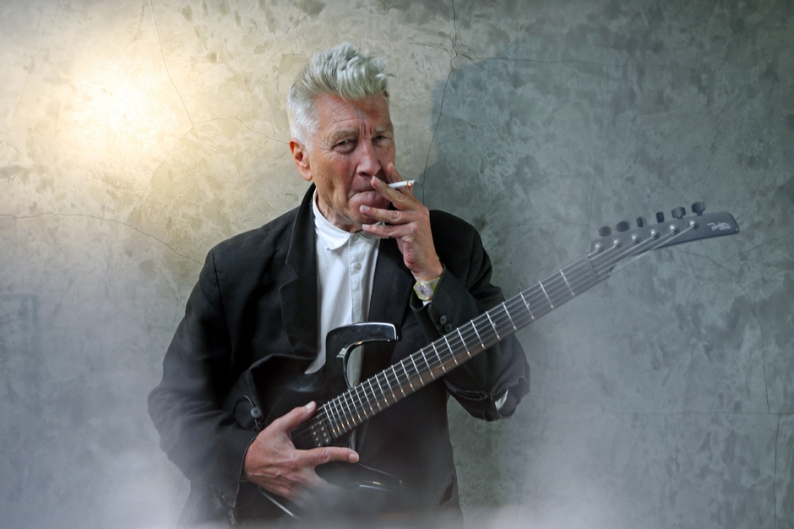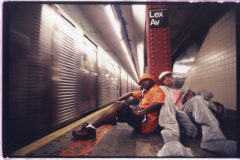Director David Lynch, 67, has achieved cineaste godhood and popular acclaim as a mastermind of mind-bending film masterpieces like Eraserhead, Blue Velvet, and the Twin Peaks TV show. Though the Montana native and coffee connoisseur hasn’t released a film since 2006’s Inland Empire, he’s had music to keep him busy, collaborating with Danger Mouse on 2010’s Dark Night of the Soul album, releasing his own debut effort Crazy Clown Time in 2011, and more recently directing Nine Inch Nails’ “Came Back Haunted” video.
Lynch’s second album, The Big Dream (Sacred Bones), is out July 16. The album sounds pretty much exactly how you’d imagine a David Lynch album would sound: eerie and steeped in surrealism, full of reverb-soaked guitars and Lynch’s own nasal, guileless, and heavily-processed vocals. It’s a strange effort, and yet like the indelible weirdos from his films, tracks like the thumping “Star Dream Girl” and Lykke Li-guesting “I’m Waiting Here,” have a way of lingering in the mind long after they’re gone.
What was the last dream you had?
I don’t remember my dreams too much. I hardly have ever gotten ideas from nighttime dreams. But I love daydreaming, and dream logic and the way dreams go. They are an influence because of just the way they are. One of the beautiful powers of cinema is taking that logic.
In your book Catching the Big Fish, you speak extensively about transcendental meditation. What role — if any — did TM play in developing and evolving ideas for the album?
Well, transcendental meditation is an ancient mental technique that allows any human being to dive within, transcend and experience the source of everything. It’s such a blessing for the human being because that eternal field is a field of unbounded intelligence, creativity, happiness, love, energy and peace. And when you truly transcend that experience, you grow in those qualities and expand consciousness. And when you expand consciousness, you are literally making the subconscious more and more conscious. When it all becomes consciousness you can catch ideas at a deeper level — it really feeds the work. You get more energy to do the work, you get different ideas, and then you see them more clearly, and you can see the way to transcend them into a certain medium. It’s very beautiful.
You’ve self-described your forthcoming release The Big Dream as a “blues album.” Were the blues something you grew up with, or did you come to appreciate blues later in life?
I didn’t really grow up listening to blues, because I grew up in the Northwest. It wasn’t really the center for blues. When rock and roll got born, it was like a fire started. A really hot fire. Something was happening that had never happened before, and that was super powerful. And rock and roll, you know, has its roots in rhythm and blues. So one thing leads to another, and then you start discovering other things. I love when the blues got electrified, like Chicago blues.
What were some of the blues groups that you can remember electrifying you?
When I heard John Lee Hooker, I thought that was pretty spectacular. I love the feel and mood of Sonny Boy Williamson’s “Bring It On Home.” There’s something about this boogie that’s just incredible, and the guitar. I love ZZ Top, they’re one of the all-time great groups. Their new album I’m really wild about. I love Jimi Hendrix. And when he played Monterey Pop and sang “Wild Thing,” that was an unbelievable moment. I saw it in a VHS tape. In that same tape, I saw Otis Redding perform “I’ve Been Loving You.” I cried several times. I couldn’t believe how beautiful it was.
Your songs are primarily character-driven narratives, like the psychopath in “Say It,” or the femme fatale in “Star Dream Girl”. What kinds of characters are you drawn to?
The characters are there, and the next day they aren’t there. And then the next day they walk in. The character is an idea. The voice can change in so many ways, and it can trigger a character. And that’s kind of a magical moment, because here comes a character, he sings a certain way, and he’s born that way.
What landscapes do you have in mind when you create music?
Sometimes it is a landscape of a desert, some is the landscape of the Deep South. But they’re dream versions. It’s no place I’ve ever been to; it’s an imagined desert and an imagined Deep South. “Last Call” is at a bar. But everybody would have a different picture. I shouldn’t say what my exact picture is, because it putrifies it for others.
Your Vine account featured a preview of the album’s cover: a man being struck with something, presumably lightning. What was that projecting?
That man is experiencing big love. And that’s what the big dream is all about. When that man was walking down the street, and he saw you, you can picture that electric lightning bolt going through him. Big love.
What is your creative process like for making music? Do you go in with a particular idea, or is it more a stream of consciousness once you get into the studio?
Sometimes I get ideas for lyrics in anyplace, but I work a lot in the studio. So I collect little bits of lyrics. I go through the box of lyrics I have, and see if something fits. We jam, and we might have some chord in mind but we have no idea what’s going to happen. Out of the jam, there might be tiny chunks of gold. And that leads you forward. With the music, you get into it and it starts talking to you.
What dimension did Lykke Li’s vocals add to “I’m Waiting Here?”
Lykke Li actually came with something together in her head. She sat with [The Big Dream engineer] Big Dean Hurley and I sat back, watched it unfold and smoked cigarettes.
Speaking of stimulants, when was the last time you had a damn good cup of coffee?
I’m having it right now!





